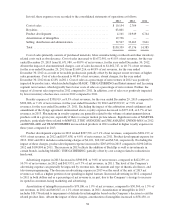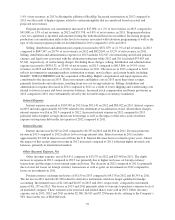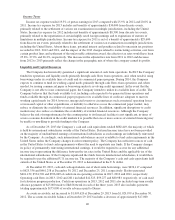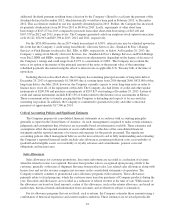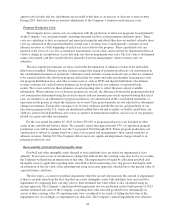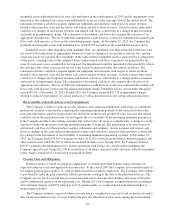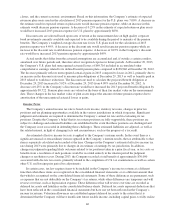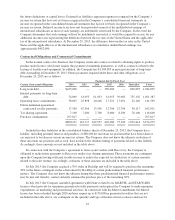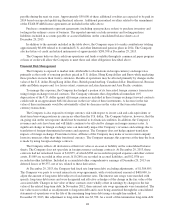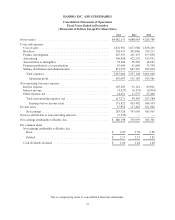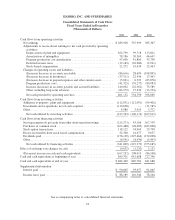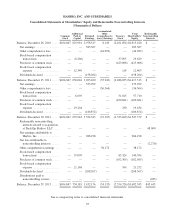Hasbro 2013 Annual Report Download - page 58
Download and view the complete annual report
Please find page 58 of the 2013 Hasbro annual report below. You can navigate through the pages in the report by either clicking on the pages listed below, or by using the keyword search tool below to find specific information within the annual report.
classes, and the current economic environment. Based on this information, the Company’s estimate of expected
return on plan assets used in the calculation of 2013 pension expense for the U.S. plans was 7.00%. A decrease in
the estimate used for expected return on plan assets would increase pension expense, while an increase in this
estimate would decrease pension expense. A decrease of 0.25% in the estimate of expected return on plan assets
would have increased 2013 pension expense for U.S. plans by approximately $630.
Discount rates are selected based upon rates of return at the measurement date on high quality corporate
bond investments currently available and expected to be available during the period to maturity of the pension
benefits. The Company’s weighted average discount rate for its U.S. plans used for the calculation of 2013
pension expense was 4.49%. A decrease in the discount rate would result in greater pension expense while an
increase in the discount rate would decrease pension expense. A decrease of 0.25% in the Company’s discount
rate would have increased 2013 pension expense by approximately $459.
Actual results that differ from the actuarial assumptions are accumulated and, if outside a certain corridor,
amortized over future periods and, therefore affect recognized expense in future periods. At December 29, 2013,
the Company’s U.S. plans had unrecognized actuarial losses of $69,716 included in accumulated other
comprehensive earnings related to its defined benefit pension plans compared to $138,946 at December 30, 2012.
The decrease primarily reflects unrecognized actuarial gains in 2013 compared to losses in 2012, primarily due to
an increase in the discount rate used to measure plan obligations at December 29, 2013 as well as benefits paid in
2013 related to workforce reductions. The discount rate used to calculate the projected benefit obligation at
December 29, 2013 increased to 5.02% at December 29, 2013 from 4.09% used at December 30, 2012. A
decrease of 0.25% in the Company’s discount rate would have increased the 2013 projected benefit obligation by
approximately $9,722. Pension plan assets are valued on the basis of their fair market value on the measurement
date. These changes in the fair market value of plan assets impact the amount of future pension expense due to
amortization of the unrecognized actuarial losses or gains.
Income Taxes
The Company’s annual income tax rate is based on its income, statutory tax rates, changes in prior tax
positions and tax planning opportunities available in the various jurisdictions in which it operates. Significant
judgment and estimates are required to determine the Company’s annual tax rate and in evaluating its tax
positions. Despite the Company’s belief that its tax return positions are fully supportable, these positions are
subject to challenge and estimated liabilities are established in the event that these positions are challenged and
the Company is not successful in defending these challenges. These estimated liabilities are adjusted, as well as
the related interest, in light of changing facts and circumstances, such as the progress of a tax audit.
An estimated effective income tax rate is applied to the Company’s interim results. In the event there is a
significant unusual or extraordinary item recognized in the Company’s interim results, the tax attributable to that
item is separately calculated and recorded at the time. Changes in the Company’s estimated effective income tax
rate during 2013 were primarily due to changes in its estimate of earnings by tax jurisdiction. In addition,
changes in judgment regarding likely outcomes related to tax positions taken in a prior fiscal year, or tax costs or
benefits from a resolution of such positions would be recorded entirely in the interim period the judgment
changes or resolution occurs. During 2013, the Company recorded a total benefit of approximately $30,000
associated with discrete tax events, primarily related to the completion of U.S. tax examinations as well as certain
other U.S. and foreign prior period tax adjustments.
In certain cases, tax law requires items to be included in the Company’s income tax returns at a different
time than when these items are recognized on the consolidated financial statements or at a different amount than
that which is recognized on the consolidated financial statements. Some of these differences are permanent, such
as expenses that are not deductible on the Company’s tax returns, while other differences are temporary and will
reverse over time, such as depreciation expense. These differences that will reverse over time are recorded as
deferred tax assets and liabilities on the consolidated balance sheets. Deferred tax assets represent deductions that
have been reflected in the consolidated financial statements but have not yet been reflected in the Company’s
income tax returns. Valuation allowances are established against deferred tax assets to the extent that it is
determined that the Company will have insufficient future taxable income, including capital gains, to fully realize
46




